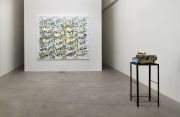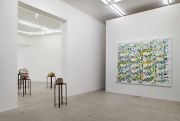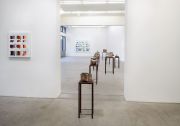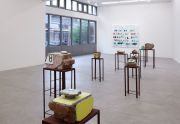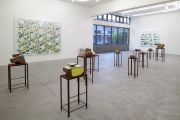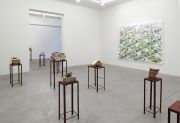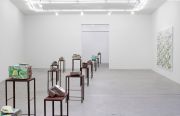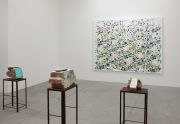Tanya Goel
Equations in a Variable
14.11.2019 - 1.2.2020
Galerie Urs Meile Lucerne
Press Release – English
Galerie Urs Meile is pleased to announce Equations in a Variable, the first solo exhibition of Indian artist Tanya Goel (*1985, lives and works in New Delhi) with Galerie Urs Meile in Lucerne. The exhibition will feature Tanya Goel’s latest paintings and sculptures.
Tanya Goel’s art is characterized by antagonisms: in her work, control and intuition, rigor and freedom, research and spirituality, structure and chaos encounter each other. This oscillation between extremes has an inherent magic of its own and is particularly distinct in the paintings by this young artist. Born in 1985 in New Delhi, Goel left India to study art in the United States. After spending a decade abroad, she returned to the city of her birth. In her artistic practice, Goel weaves together her experiences of two different systems of cultural references to shape a creative universe that is uniquely her own. In it, an important role is played by the theme of the city and its urban structure in particular.
Her paintings – some of which are in large formats – are based on a grid structure that the artist pencils onto the canvas. The grid as a motif refers to the modernist utopia in several ways. Indeed, the topic of the city as a place for new utopias was articulated most especially in nineteenth- and twentieth-century architecture, and even more particularly in the Indian cities that sprung up during the colonial era and afterward. But more on this later. The layout of these cities is defined by the concept of the grid. At the same time, it is also characteristic of various modern art movements. For instance, the work of Josef Albers (1888–1976) belongs in this context, and Tanya Goel explicitly refers to it in her work.
Just as a city is a multi-layered entity, Tanya Goel’s paintings also consist of different levels, both material and conceptual. The layers she places on top of the grid structure depict colorful, geometrical forms. Even these fragmentary, spatially shifting patterns refer to the city. They dissolve the strict grid by adding dynamism to the painting through the interplay of empty space and color. This new layer reflects the intensive, continuing research the artist conducts when she is, for example, on her way from her home in New Delhi to her studio, which lies just outside the Indian metropolis. She travels regularly to other Indian cities as well.
On her journeys she notes the striking changes that have occurred during her absence or are still ongoing. A great deal of public housing has been torn down to make way for private projects, forcing poorer residents to leave the city. These upheavals in the urban fabric can be traced back to India’s checkered history. Although the buildings from the colonial and post-colonial eras are of great architectural quality, they also reflect the failure of modernist utopianism. Foreign architects (including famous ones such as Le Corbusier and Louis Kahn) were called upon during the era of government overseen by the Indian Prime Minister Jawaharlal Nehru. Still, the urban and demographic developments of the past decades led to an imbalance between private and public spaces.
On her excursions and trips through the city the artist regularly gathers fragments of these ruins, thus allowing references to history into her work. Along with the photographic documentation of buildings decaying and vanishing, the pieces of debris she finds are incorporated into her extensive archive, which forms the basis for further artistic work. On the one hand, she makes sculptures out of them, and on the other hand, she uses these objects to manufacture her own pigments.
Color is a theme that is of central importance in the artist’s work. “Color is light, material, and surface,” says Goel in conversation. “It is both fact and fiction.” She researches these multiple aspects from a theoretical as well as a practical standpoint. This culminates in, for example, a study of Goethe’s color theories. Goel is also interested in the history and significance of paint pigments in India. Coming from a textile-manufacturing family, she is particularly sensitive to this theme. She often uses fragments of fabric in her paintings, because they absorb light in a different way than pigment does. On a very practical level, this kind of research results in scientific lab work, in which she takes the urban gems she has found and grinds them into powder to make her own pigments. In turn, these are later mixed with cement, lending the colors a certain kind of plasticity, while at the same time creating a material sense of proximity to their urban origins. All of this makes Tanya Goel’s paintings akin to physical urban landscapes in which viewers can immerse themselves.
A dialogue with the local context of the artist’s home country also takes place when viewing her sculptures. Most of the building fragments still bear traces of faded colors, while new layers of color are added to them. The geometrical shapes of these colored planes respond to the form of each fragment. In this way Goel creates a sense of tension between the found object and her artistic intervention. Placing the painted blocks on elevated metal pedestals produces an immediate physical encounter at eye level. The pedestals come from textile factories that were forced to close in recent years. In these works, too, diverse realities meet and turn into a new, symbolic object. Historical and economic references overlap with the institutional museum practice of display. The self-referential gesture is typical of Goel’s reflective practice of art.
The artist’s work method is characterized by the simultaneous presence of spontaneous interventions and calculated systems of order. Goel deliberately plays with the ambiguity this creates, which is strongly tied to the diametrically opposed poles of body and mind, as well as spirituality and science. In the gestural formal repetition, the intuitive movement of her body enters into a dialogue with the strict order of the algorithmic grid. The paintings thus created weave together a wide network of references to both international art—such as Hilma af Klint or Russian constructivism—and to local art, such as Indian miniature painting or tantric art. The amalgamation of these different worlds resembles an alchemical process.
Tanya Goel was born in New Delhi in 1985 and studied at the Faculty of Fine Arts, MS University, Baroda, India and the School of the Art Institute of Chicago, USA before receiving her Master’s degree in Fine Arts from Yale University in 2010. She had a solo exhibition with Nature Morte in New Delhi (2017) as well as two solo exhibitions with Gallery Mirchandani + Steinruecke in Mumbai (2011 and 2015). Her works are in the collections of the Kiran Nadar Museum of Art, New Delhi, Philadelphia Museum of Art, Philadelphia, PA, the Art Gallery of Alberta, Canada, and UBS Bank, Zurich. In 2018, she participated in the Sydney and Gwangju biennials.
Text by Susanna Koeberle, freelance journalist
Press Release – Deutsch
Galerie Urs Meile freut sich Equations in a Variable, die erste Einzelausstellung der indischen Künstlerin Tanya Goel (*1985, lebt und arbeitet in New Delhi) in der Luzerner Galerie anzukündigen. In der Ausstellung werden Tanya Goels neueste Malereien und Skulpturen zu sehen sein.
Tanya Goels Kunst ist geprägt durch Antagonismen: In ihren Arbeiten begegnen sich Kontrolle und Intuition, Strenge und Freiheit, Forschung und Spiritualität, Struktur und Chaos. Diesem oszillierenden Charakter zwischen Extremen wohnt eine eigentümliche Magie inne. Das zeigt sich besonders ausgeprägt in der Malerei der jungen Künstlerin. Einige davon sind auch in der ersten Solo-Ausstellung in der Galerie Urs Meile Luzern zu sehen. 1985 in New Delhi geboren, verlässt Goel Indien, um in den USA Kunst zu studieren. Nach einem Jahrzehnt im Ausland kehrt sie in ihre Heimatstadt zurück. Die Erfahrung der unterschiedlichen kulturellen Referenzsysteme verwebt Tanya Goel in ihrer künstlerischen Praxis zu einem eigenen gestalterischen Universum. Dabei spielt das Thema Stadt und im Besonderen ihre urbane Struktur eine wichtige Rolle.
Basis für ihre zum Teil grossformatige Malerei ist eine Rasterstruktur, welche die Künstlerin mit Bleistift auf die Leinwand anbringt. Dabei nimmt das Motiv des Rasters in mehrfacher Hinsicht auf die Utopie der Moderne Bezug. Die Stadt als Ort eines utopischen Neubeginns ist ein Topos, der speziell in der Architektur des 19. und 20. Jahrhunderts seinen Ausdruck findet – gerade auch in den Städten Indiens, die während der Kolonialzeit und danach entstehen. Doch dazu später mehr. Das räumliche Layout dieser Städte ist durch die Idee des Rasters definiert. Diese ist zugleich prägend für verschiedene Strömungen der modernen Kunst. Diesbezüglich ist etwa die Arbeit von Josef Albers (1888 – 1976) zu erwähnen, welche die Künstlerin explizit als Referenz anführt.
So wie die Stadt ein vielschichtiges Gebilde ist, konstituieren sich auch Tanya Goels Bilder durch verschiedene Schichten und zwar materiell wie auch ideell. Die Lagen, welche auf die Rasterstruktur zu liegen kommen, stellen farbige geometrische Formen dar. Auch diese fragmentarischen und räumlich ver-rückten Muster nehmen auf Stadt Bezug. Sie lösen die strenge Rasterstruktur gleichsam auf und dynamisieren das Bild durch das Wechselspiel von Leerraum und Farbe. Diese neue Schicht widerspiegelt die intensive und fortdauernde Recherchearbeit, welche die Künstlerin etwa auf dem Weg von ihrem Wohnort New Delhi zu ihrem Atelier etwas ausserhalb der indischen Metropole unternimmt. Sie bereist aber regelmässig auch andere indische Städte.
Dabei beobachtet sie markante Veränderungen, welche im Verlauf ihrer Abwesenheit stattgefunden haben und immer noch im Gange sind. Viele öffentliche Wohnbauten werden abgerissen und müssen privaten Bauprojekten weichen, was die ärmere Bevölkerung dazu zwingt, die Stadt zu verlassen. Diese Umbrüche im städtischen Gewebe lassen sich auf die bewegte Geschichte Indiens zurückführen. Die Bauten aus der Zeit des Kolonialismus und des Postkolonialismus sind zwar von hoher architektonischer Qualität, reflektieren aber zugleich das Scheitern der Utopie der Moderne. Die ausländischen Architekten (dazu gehören etwa bekannte Baukünstler wie Le Corbusier oder Louis Kahn) wurden während der Regierung des indischen Premierministers Jawaharlal Nehru aufgeboten. Doch die urbane und demografische Entwicklung der letzten Jahrzehnte führte zu einem Ungleichgewicht zwischen privatem und öffentlichem Raum.
Die Künstlerin sammelt auf ihren Ausflügen und Fahrten durch die Stadt regelmässig Fragmente dieser Ruinen und lässt auf diese Weise historische Bezüge in ihr Werk einfliessen. Zusammen mit einer fotografischen Dokumentation der zerfallenden und verschwindenden Bauten werden die gesammelten Fundstücke Teil eines umfangreichen Archivs. Dieses bildet die Basis für eine weitere künstlerische Verarbeitung. Zum einen entstehen daraus skulpturale Arbeiten, zum anderen verwendet sie diese Objekte zur Herstellung eigener Farbpigmente.
Das Thema Farbe besitzt in der Arbeit der Künstlerin einen zentralen Stellenwert. „Farbe ist Licht, Material und Oberfläche“, sagt Goel im Gespräch. „Sie ist zugleich Fakt und Fiktion“. Diese multiplen Aspekte werden theoretisch und praktisch erforscht. Das mündet zum Beispiel in einer Beschäftigung mit Goethes Farbtheorien. Auch die Geschichte und Bedeutung der Farbpigmente in Indien interessiert sie. Aus einer Textilfamilie stammend, ist sie besonders sensibilisiert für dieses Thema. Häufig setzt sie in ihren Bildern textile Fragmente ein, die das Licht auf eine andere Weise absorbieren als die Pigmente. Auf einer ganz praktischen Ebene führt diese Recherche zu einer wissenschaftlichen Laborarbeit, bei der sie die städtischen Trouvaillen zu Pulver verarbeitet und daraus ihre eigenen Farbpigmente macht. Diese wiederum werden später mit Zement gemischt, was den Farben eine gewisse Plastizität verleiht und zugleich eine materielle Nähe zur städtischen Herkunft erzeugt. Die Bilder von Tanya Goel gleichen dadurch physischen urbanen Landschaften, in welche die Betrachter eintauchen können.
Ein Dialog mit dem örtlichen Kontext des Heimatlandes der Künstlerin findet auch beim Betrachten ihrer Skulpturen statt, die in der Ausstellung gezeigt werden. Die Baufragmente tragen meistens noch Spuren von verblassenden Farben; sie werden zusätzlich mit neuen Farbschichten versehen. Die geometrischen Formen dieser Farbflächen antworten auf die jeweilige Gestalt des Fragments. Damit kreiert Goel eine Spannung zwischen dem vorgefundenen Objekt und ihrem künstlerischem Eingriff. Das Platzieren der bemalten Blöcke auf erhöhten Metallgestellen bewirkt eine unmittelbare physische Begegnung auf Augenhöhe. Die Sockel stammen aus Textilfabriken, die in den letzten Jahren schliessen mussten. Auch bei diesen Arbeiten begegnen sich unterschiedliche Realitäten, die zu einem neuen symbolischen Objekt gefügt werden. Die historische und wirtschaftliche Bezugnahme überlagert sich dabei mit der musealen Praxis des Dispositivs. Die selbstrefenzielle Geste ist typisch für Tanya Goels reflektierende künstlerische Praxis.
Die Arbeitsweise der Künstlerin ist durch die Gleichzeitigkeit von spontanen Interventionen
und kalkulierten Ordnungssystemen gekennzeichnet. Goel spielt bewusst mit der daraus entstehenden Ambiguität, die stark an die beiden gegensätzliche Pole Körper und Geist sowie Spiritualität und Wissenschaft gebunden ist. In der gestischen, formalen Repetition tritt die intuitive Bewegung ihres Körpers in ein Zwiegespräch mit der strengen Ordnung des algorithmischen Rasters. Die so entstehenden Bilder knüpfen ein weites Netz an Referenzen, sowohl zu internationalem – wie Hilma af Klint oder dem russischen Konstruktivismus – als auch zu lokalem Kunstschaffen – wie der indischen Miniaturmalerei oder der tantrischen Malkunst. Das Amalgamieren dieser unterschiedlichen Welten kommt einem alchemistischen Prozess gleich.
Tanya Goel wurde 1985 in Neu-Delhi geboren und studierte an der Faculty of Fine Arts, MS University, Baroda und dem School of the Art Institute of Chicago, bevor sie 2010 ihren Master-Abschluss in Bildender Kunst von der Yale University erhielt. Sie hatte eine Einzelausstellung mit Nature Morte in
Neu Delhi (2017) und zwei mit der Galerie Mirchandani + Steinruecke in Mumbai (2011 und 2015). Ihre Werke befinden sich in den Sammlungen des Kiran Nadar Museum of Art, New Delhi, des Philadelphia Museum of Art, Philadelphia, PA, der Art Gallery of Alberta, Kanada, und der UBS Bank, Zürich. Sie nahm 2018 an den Biennalen in Sydney und Gwangju teil.
Text von Susanna Koeberle, freischaffende Journalistin
Downloads
Press Release (English, PDF)
Press Release (Deutsch, PDF)
Events
Opening:
Thursday, November 14, 2019, 5.30 - 7.30pm

